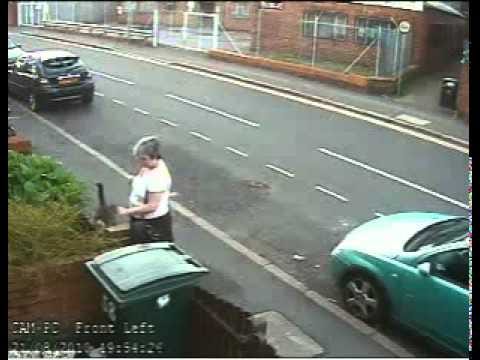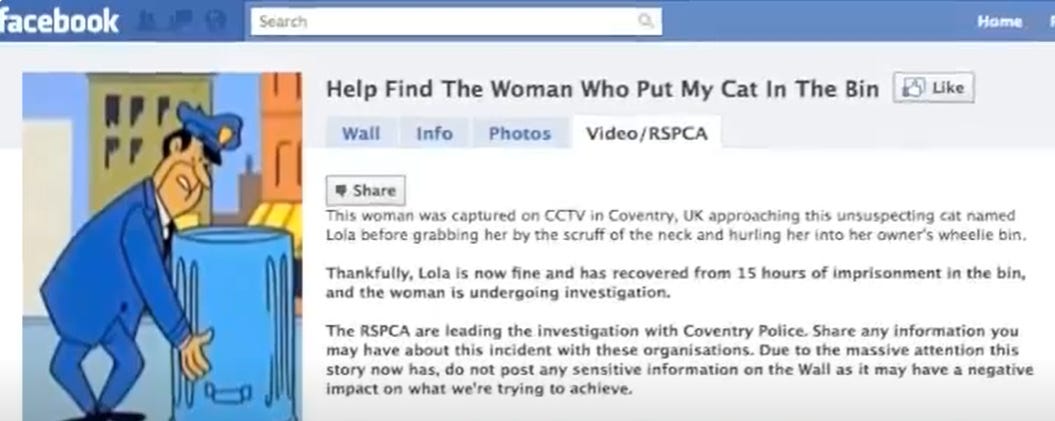Whoever fights monsters should see to it that in the process he does not become a monster. And if you gaze long enough into an abyss, the abyss will gaze back into you.
— Friedrich Nietzsche
***
The Cat Bin Lady
On August 21, 2010, Mary Bale from Coventry, England, did something that would change her life. It was stupid, heartless, and callous… but more importantly, it was caught on camera.
As she walked down the street, she encountered a medium-sized tabby cat. At first, all seemed well. Mary stopped to pet the cat in a playful, but altogether normal way. Then, she glanced around, pausing for a moment as if thinking about her next move. After one last look about, she reached down, grabbed the cat by the scruff of its neck, and dropped it into a garbage bin and closed the lid. Without any further hesitation, she walked off as if nothing had happened.
But this was far from over.
Roughly fifteen hours later, the couple who owned the cat realized she never came home. They began a search for 4-year-old Lola, eventually finding her in the trash receptacle, covered in garbage and her own waste. Returning home, the couple created a page on Facebook called Help Find The Woman Who Put My Cat In The Bin (long since removed). The human cat-parents, Darryl and Stephanie-Andrews Mann, reviewed their home CCTV and discovered that they had captured the whole thing on video. Darryl added it to the Facebook page.
Source: Top Cat In Bin News on YouTube.
Within five days, the Manns’ page had 15,000 followers. Just weeks after posting the video, the Manns’ page had over 100,000 comments, few that were even remotely sympathetic to the woman in the video, some calling for her death. For reference, in 2011, Coventry had a population of just 316,960 men, women, and children. A separate Facebook page sprang up in the days after the Manns posted the video calling for the perpetrator to be jailed. It received 5,000 followers.
Less than twenty-four hours after the video went live, online sleuths identified the woman, her address, and her employer and blasted this information across the web. Once her name entered the public sphere, Mary made her second error. She gave a news interview to the Sun newspaper in which she said two things that took a viral story into a much darker place:
I did it as a joke because I thought it would be funny. I never thought it would be trapped… It’s just a cat.
What followed was a torrent of real-world anger and hate. Mary closed her social media accounts and shut off her phone. She did so after receiving innumerable death threats on both, including several who offered to dismember her. One or more people vandalized her home. She refused to leave her house and even took leave time from her job after her boss phoned her to ask, “Is it you?” He had recognized her from the news that had repeatedly played the CCTV clip. The situation reached such a crescendo that police formed an around-the-clock detail at her home for her protection.
Mary’s mother tried to simmer things down, but her statement did not help much. She told the Express:
Mary said she just didn’t know what had possessed her, or what came over her. It’s just very strange because she cannot explain her actions at all. She absolutely adores cats and would have one of her own if she could. She works all day though so she didn’t think it was fair to leave a cat alone.
The London Sun followed that interview with its own article, titled “Cruel cat woman named and shamed.” A few days later, someone created a satirical Twitter account, called “catbinlady,” that includes Mary’s face from the CCTV footage as its profile picture. For a while it comedically posted various terrible activities done in a "moment of madness," employing a twisted version of Mary’s mother’s statement. Although the account has not posted in years, it still exists with 15.3 thousand followers.
Following the tumult, the RSPCA began its own investigation. A spokesman said, “We will be putting together a full case file to put before our prosecutions department before we decide whether to proceed.” About seven months later, the agency did file charges and Mary ultimately agreed to plea to an animal cruelty charge and pay a fine of £250. A court also ordered her to pay £1,171 in costs and banned her from keeping or owning animals for the next five years. The judge overseeing the plea stated, “The media interest in this case has resulted in you being vilified in some quarters and I have taken that into account.”
Afterwards, Mary claimed to have suffered depression from the incident. Her employer, the Royal Bank of Scotland, put her on paid leave under extensive pressure to fire her and because Mary presented her boss with a doctor’s note stating she was unfit to work. Although unconfirmed by official sources, it seems she ended up moving out of her neighborhood in the year or two after the incident upon facing “shame” from her neighbors.
Who are the Monsters?
I could not find what happened to Mary Bale since then (upon an admittedly only casual search), and perhaps that is for the better. But this incident does raise some interesting questions about our relationship with technology and the world. First let me say, I love cats. I love all animals, but especially cats, and what this woman did was unnecessary, arrogant, and deserving of some punishment.
But as Nietzsche observed, we should be cautious when we fight monsters that we ourselves do not become one. Did Mary deserve the opprobrium she received for her actions? To some degree, most definitely. Would the court system in England have handed down some punishment without the online and media driven furor? I think probably not. Did she deserve to be driven from her home, and maybe her job, and receive death threats to the extent that she needed police protection? No.
Clearly, this sort of internet shaming (absent the threats of violence) has its uses. Without it, Mary might have gone unpunished—or even undiscovered—and would thus have been free to persist in a campaign of bin-stuffing innocent little kitties. But in a world where justice is becoming a purchasable commodity like everything else, there is a broader implication to this kind of activism.
On July 9, Cyberscoop reported that “hacktivists” breached the databases of the Heritage Foundation. For quick context, the Heritage Foundation identifies itself as a "conservative think tank.” More accurately, the Foundation is made up of former Trump officials and various political commentators, supported by billionaires, that has publicly avowed to overthrow the United States government and “remake” it in its own vision. For more detail, see this article.
The above statement is not hyperbole. Just a few days ago on currently-imprisoned Steve Bannon’s podcast, the president of the Foundation told US Representative Dave Brat, “we are in the process of the second American Revolution, which will remain bloodless if the left allows it to be” [emphasis added]. Whatever one’s politics, the meaning of this statement could not be clearer.
The Foundation has also released a roughly 900-page manifesto of the various policies it wants implemented should their candidate of choice come to power. These include:
Eliminating environmental protections
Gutting the Food and Drug Administration’s authority
Replacing federal civil servants with loyalists
Passing massive tax cuts for the rich
Abolishing the Department of Education
Slashing disability benefits for veterans
And the list goes on.
The hacker group—“the hacktivists”—that breached the Foundation’s servers stated that it intended to provide “transparency to the public regarding who exactly is supporting” this organization. Hacktivists is not the group’s name, but a characterization of their motives. Hacktivism is simply the use of “computer technology to make a statement supporting” a political or social cause—the 21st century version of civil disobedience.
SiegedSec, the hacker group’s actual moniker, released the “full names, email addresses, passwords, and usernames” of Heritage Foundation members and supporters, some of which are current employees or representatives of the federal government, according to the data in the dump.
Much of what the Foundation plans to do is likely illegal or unconstitutional. And its organizers seem to know it. If one chooses to apply for membership, the terms of service to which one must agree spans numerous paragraphs demanding that the applicant remain silent about any internal activities under threat of lawsuit.
With its backing by billionaires, the threat of abusing the courts to silence critics or whistleblowers is real. In this way, such an organization can engage in whatever evil it likes behind the scenes because law-abiding folks, including investigative journalists, will be reluctant to publicly call it out. Since black-hat hackers are, by their very nature, unconcerned with such things, they may be the only ones out there willing to force this kind of malevolence into the public eye where it can get the necessary scrutiny.
In a world of increasing inequality, where the richest control virtually everything, this kind of anarchic approach may end up being the only method left to fight against high-powered villainy. While I am not encouraging or condoning lawbreaking, if one is inclined to engage in this sort of behavior, it would be more noble to direct it at society’s biggest monsters and leave the Mary Bales to local condemnation.
Put on the whole armor of God, that you may be able to stand against the schemes of the devil. For we do not wrestle against flesh and blood, but against the rulers, against the authorities, against the cosmic powers over this present darkness.
—Ephesians 6:10-18
For a detailed history of how wealthy-elites effectively stole power, click below.
I am a Certified Forensic Computer Examiner, Certified Crime Analyst, Certified Fraud Examiner, and Certified Financial Crimes Investigator with a Juris Doctor and a Master’s degree in history. I spent 10 years working in the New York State Division of Criminal Justice as Senior Analyst and Investigator. I was a firefighter before I joined law enforcement.





